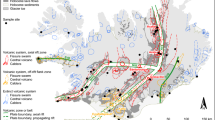Abstract
A thermal conductivity map can serve as a good basis for ground-source heat pump projects in the pre-design phase. However, due to large variations, a thermal response test is required for larger projects to get the accurate values needed for proper design of the ground-source heat pump system. This study describes the systematic methodology for producing such a thermal conductivity map of a larger geographic area around Oslo, Norway. The map is based on the results of 1,398 thermal diffusivity measurements of rock core samples. The thermal diffusivity is measured and used in the calculation of the thermal conductivity of the different geological units in the bedrock map of the Oslo region. Large variations in thermal conductivity data were registered within the data sets for the different rock polygons and geological units and the greatest variation is found in metamorphic and sedimentary rocks. Rock polygons and geological units with magmatic origin show the least variation within the data sets. The internal micro structures of the rocks can have a strong influence on the thermal conductivity. This is pronounced in some foliated metamorphic rocks where the thermal conductivity is highest parallel to the orientation of the foliation. The median value for the whole data set is 2.62 W/(m K), while the minimum and maximum value is 1.0 and 6.88 W/(m K), respectively. The minimum value is a breccia, and the maximum value was measured in a quartzite/metasandstone. The lower and upper quartiles for the sets of rock polygons and geological units are 2.1–3.9 W/(m K), respectively.











Similar content being viewed by others
References
Banks D, Midtgård AaK, Frengstad B, Krog JR, Strand T et al (1998) Utjevningsbassengs innvirkning på radoninnholdet I grunnvann fra fast fjell. (In Norwegian). The Geological Survey of Norway, NGU-report 98.097. Title in English: Effect of storage basins on radon content in groundwater from bedrock aquifers. p 16
Clauser C, Huenges E (1995) Thermal conductivity of rocks and minerals. In: Ahrens TJ (ed) Rock physics and phase relations––a handbook of physical constants. American Geophyscial Union, Washington, pp 105–126
Liebel HT (2012) Influence of groundwater on measurements of thermal properties in fractured aquifers. Doctoral theses at NTNU, vol 113, p 163
Liebel HT, Stølen MS, Frengstad BS, Ramstad RK, Brattli B (2012) Insights into the reliability of different thermal conductivity measurement techniques: a thermo-geological study in Mære (Norway). Bull Eng Geol Environ 71:235–243
Lutro O, Nordgulen Ø (2008) Oslofeltet, berggrunnskart M 1:250,000. The Oslo Region Bedrock map 1: 250,000. Geological Survey of Norway
Middleton MF (1993) A transient method of measuring the thermal properties. Geophysics 58(3):357–365
Midttømme K and Hilmo BO (2000) Kartlegging av grunnvarme fra fjell––sluttrapport. (In Norwegian). The Geological Survey of Norway, NGU-report 2000.034. Title in English: Mapping of ground source heat of the bedrock—final report, p 15
Midttømme K, Hilmo BO, Skarphagen H, Nissen A (2000) Kartlegging av energipotensialet i berggrunnen på kartblad Bekkestua, Bærum kommune: Varmeledningsevnen til bergarter.(In Norwegian). The Geological Survey of Norway, NGU-report 2000.036, Title in English: Mapping of the energy potential in the bedrock of the map sheet Bekkestua, Bærum municipality: thermal conductivity of rocks, p 105
Popov Y (2012) Evolution in the reliability of experimental geothermal data. In: Huddlestone-Holmes C, Gerner E (eds) Proceedings of the 2012 Australian geothermal energy conference, Sydney, pp 138–145
Raade G (1973) Distribution of radioactive elements in the plutonic rocks of the Oslo region. Thesis at University of Oslo
Ramstad RK (2011) Grunnvarme i Norge––Kartlegging av økonomisk potensial. (In Norwegian). Report on commission #5 2011 for the Norwegian Water Resources and Energy Directorate prepared by Asplan Viak AS, p 87. Title in English: Ground source energy in Norway––Mapping of economic potential
Ramstad RK, deBeer H, Midttømme K, Koziel J, Wissing B (2008) Thermal diffusivity measurements at NGU—status and method development 2005–2008. NGU-report 2008.050, p 41
Reimann C, Arnoldussen A, Englmaier P, Filzmoser P, Finne TE et al (2007) Element concentrations and variations along a 120-km transect in southern Norway—Anthropogenic vs. geogenic vs. biogenic element sources and cycles. Appl Geochem 22(4):851–871
Slagstad T and Cramer J (2005) Boringer fyller kunnskapshullene. Geo Oktober 2005 page 40–42. Title in English: Drilling fills the holes of knowledge
Author information
Authors and Affiliations
Corresponding author
Rights and permissions
About this article
Cite this article
Ramstad, R.K., Midttømme, K., Liebel, H.T. et al. Thermal conductivity map of the Oslo region based on thermal diffusivity measurements of rock core samples. Bull Eng Geol Environ 74, 1275–1286 (2015). https://doi.org/10.1007/s10064-014-0701-x
Received:
Accepted:
Published:
Issue Date:
DOI: https://doi.org/10.1007/s10064-014-0701-x




